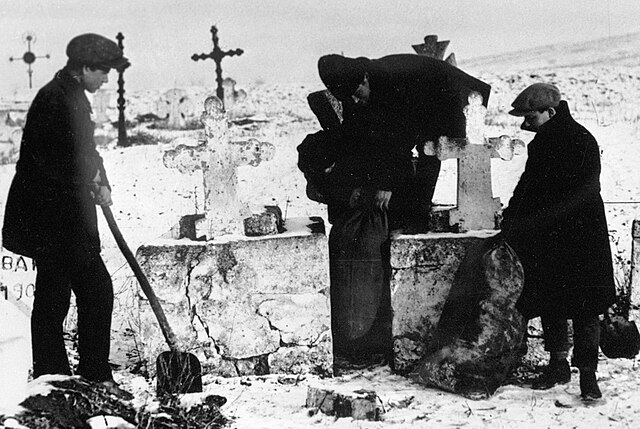Dekulakization was the Soviet campaign of political repressions, including arrests, deportations, or executions of millions of kulaks and their families. Redistribution of farmland started in 1917 and lasted until 1933, but was most active in the 1929–1932 period of the first five-year plan. To facilitate the expropriations of farmland, the Soviet government announced the "liquidation of the kulaks as a class" on 27 December 1929, portraying kulaks as class enemies of the Soviet Union.
A parade under the banners "We will liquidate the kulaks as a class" and "All to the struggle against the wreckers of agriculture"
Children of kulaks in Northern krai, 1930
Kulak women in a forest cutting 1930
1930s Soviet propaganda poster stating: "Oust kulaks from kolkhozes!"
Political repression in the Soviet Union
Throughout the history of the Soviet Union, tens of millions of people suffered political repression, which was an instrument of the state since the October Revolution. It culminated during the Stalin era, then declined, but it continued to exist during the "Khrushchev Thaw", followed by increased persecution of Soviet dissidents during the Brezhnev era, and it did not cease to exist until late in Mikhail Gorbachev's rule when it was ended in keeping with his policies of glasnost and perestroika.
Corpses of hostages executed by Cheka in 1918 in the basement of Tulpanov's house in Kherson, Ukrainian SSR, The Black Book of Communism
Corpses of people executed by Cheka in 1918 at a yard in Kharkiv, Ukrainian SSR, The Black Book of Communism
The contemporary caption says "YCLers seizing grain from kulaks which was hidden in the graveyard, Ukraine, 1930." At the height of collectivization anyone resisting it was declared a "kulak"
People of Vinnytsia searching through the exhumed victims of the Vinnytsia massacre, 1943








